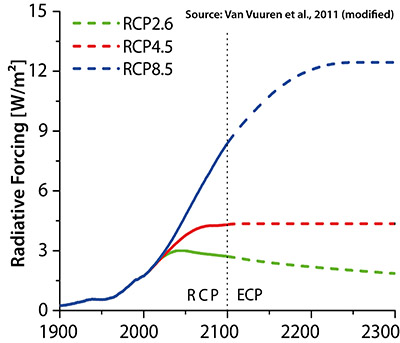
The Representative Concentration Pathways (RCPs) represent the full bandwidth of possible future emission trajectories. For the time period between 1860 and 2005, the progression of radiative forcing or greenhouse gas concentrations match the observed past. For 2006 - 2100, the RCPs show different possible future scenarios. Depending on population growth and the development of energy production, food production and land use, various emission trajectories are possible.

Using a simple carbon cycle climate model, CO2, concentrations of other greenhouse gases and aerosols were calculated. These calculations correspond to a change in radiation, showing an increase between 2.6 and 8.5 W/m2 by the year 2100, depending on the scenario. The name of each scenario corresponds to the growth in radiative forcing reached by 2100.
• RCP2.6: radiative forcing reached nearly 3 W/m2 (equal to 490 ppm CO2 equivalent) and will decrease to 2.6 W/m2 by 2100
• RCP4.5: Stabilization with overshooting. 4.5 W/m2 by 2100 (~650 ppm CO2 equivalent)
• RCP6: Stabilization with overshooting. 6 W/m2 by 2100 (~850 ppm CO2 equivalent) [this scenario is not represented as it was not carried out by Hamburg’s calculations]
• RCP8.5: rising radiative forcing, leading to 8.5 W/m2 by 2100 (equivalent to 1370 ppm CO2 equivalent)
The RCPs were also carried out for the time period 2006 to 2300. These Extended Concentration Pathways (ECPs) allow possible future long-run climate change impacts to be studied.
You will find a detailed overview of the development of the RCP Scenarios in this article: Detlef P. van Vuuren, Jae Edmonds, Mikiko Kainuma, Keywan Riahi, Allison Thomson, Kathy Hibbard, George C. Hurtt, Tom Kram, Volker Krey, and Jean-Francois Lamarque, et al., 2011: The representative concentration pathways: an overview
